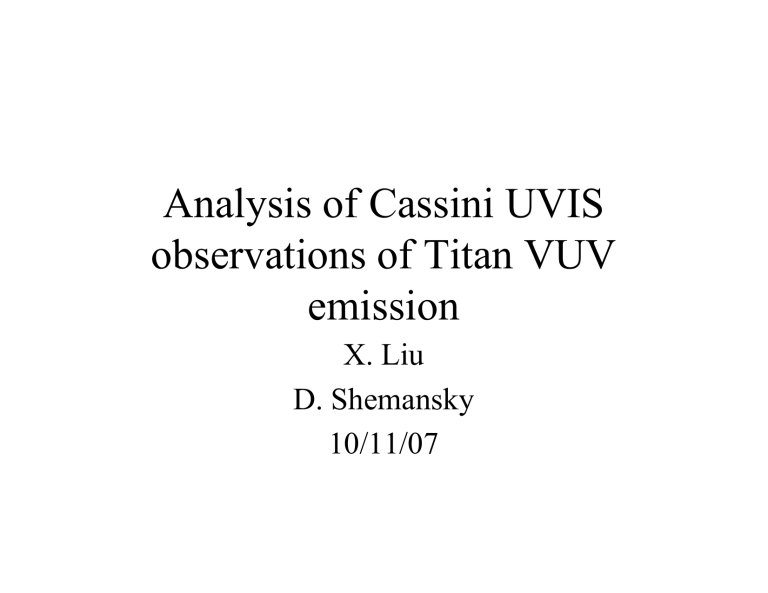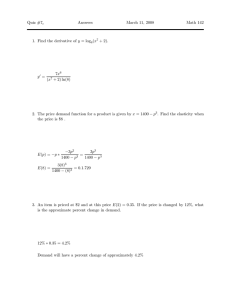Analysis of Cassini UVIS observations of Titan VUV emission X. Liu

Analysis of Cassini UVIS observations of Titan VUV emission
X. Liu
D. Shemansky
10/11/07
UVIS Imaging Spectrographs
•Telescopic spectrographs imaging 64 contiguous spatial pixels 1 mrad/px projected on sky. (Full width 3.2
o )
•1024 spectral pixels 0.25 mrad/px projected on sky.
•EUV: 55. nm – 115. nm with solar occ port
•FUV: 110. nm – 190. nm
•Spectral resolution 0.23 nm – 0.48 nm
Atomic and molecular emission
• N2, NI, NII, CI identified and modeled
• Results for nitrogen are comparable or lower than Strobel & Shemansky(1982), and Hall et al (1992) from Voyager UVS.
• Scattered solar photons (
λ
> 154 nm) from aerosols are measurable at high and low phase from 1400 km downward.
f u v 2 0 0 4 _ 1 8 4 _ 1 0 _ 4 0 _ 0 6 _ u _ c m 2 s _ t
1 0 0
9 0
8 0
7 0
6 0
5 0
4 0
1 8 4 _ r 2 3 _ r 3 9 _ a v g m o d e l_ t o t a l s o lr e f l_ t it _ 0 2 _ 0 5
C I_ m o d e l
N
N I I
N I
2
L B H
3 0
2 0
1 0
0
1 1 0 0 1 2 0 0 1 3 0 0 1 4 0 0 1 5 0 0
λ
( A )
1 6 0 0 1 7 0 0 1 8 0 0 1 9 0 0
UVIS FUV Titan 2004 DOY 184 disk average
90
80
70
60
50
UVIS Titan data model_total
40
30
20
10 NI CI Solar reflection
0
1100 1200 1300 1400 1500 1600 1700 1800 1900
λ
(A)
50
40
30
20 cuv_fu1_n2lbh_tit_00
Transmission of N2 LBH through
Titan atmosphere
N2LBH_00_00
N2LBH_00_03
N2LBH_00_04
00_00: no extinction
00_03: CH
4
= 2.06 X 10
18
; C
2
H
2
=2.05 X 10
16
C
2
H
4
=1.1 X 10
16
; C
2
H
6
=5.0 X 10
16
00_04: CH
4
= 1.12 X 10
17
; C
2
H
2
=1.11 X 10
15
C
2
H
4
=5.97 X 10
14
; C
2
H
6
=2.71 X 10
15
10
0
1200 1300 1400 1500 1600
λ
(A)
1700 1800 1900
Distribution of N
2
states a’
1 Σ u a’
1 Σ u w
1 Δ u a’
1 Σ u
(9)
τ
~ 3 ms
(5)
τ
~ 9 ms
(0)
τ
~ 67
μ s higher v levels 100% predissociative
(1)
τ
~ 7 s a
1 a’
1
Π g
Σ -
(0)
τ
= 140
μ s
W
3 Δ u u
(0)
τ
unknown
B’
3 Σ -
(0) u
(0)
B
3
A
3
Π g
Σ +
(0)
X
1 Σ + g u
(0)
τ
~ 2 s
0.0011
0.0010
0.0009
0.0008
0.0007
0.0006
0.0005
0.0004
0.0003
0.0002
0.0001
0.0000
1200 cuv_fu1_n2_x_z_06_xx_00a
N
2
multistate model n2_x_z_06_03_sc n2_lbh_04_cm2_sc n2_06_06_cm2_sc
1300
λ
(A)
1400 1500
0.0011
0.0010
0.0009
0.0008
0.0007
0.0006
0.0005
0.0004
0.0003
0.0002
0.0001
0.0000
1400 1500 cuv_fu1_n2_x_z_06_xx_00
N
2
multistate model a - X (6,7)
A - X (10,0) w - X (0,4)
1600
λ
(A)
1700 n2_x_z_06_03_sc n2_lbh_04_cm2_sc n2_06_06_cm2_sc
A - X (6,0)
1800 1900
10
0
4
10
2
-1
4
10
2
-2
4
10
2
-3
4
10
2
-4
4
10
2
-5
4
10
2
-6
4
10
2
-7
4
10
2
-8
4
10
2
-9
0 n2_x_z_06_xx_dm
N
2 nonLTE state densities vs ambient electron density
2 4 6
T e
= 200 K
8 10 state
[e]=10
10
cm
-3
[e]=10
8
cm
-3
[e]= 10
7
cm
-3
[e]=10
6
cm
-3
[N
X
] > 1 - 11
[N
A
] > 12 - 19,22,25,28,30,32,36,
38,43,48.50,56,60,64,69
12 14 16 18 20
Titan TA
FUSC4_titan_revA_gxz100_vims
3.0
2.5
2.0
1.5
1.0
0.5
0.0
-2 -1 0
R
T
1
H Ly
α
Solar reflection X 1/3
NI_1200 x 10
N2_LBH_1380 X 40
2
TA_em_dist_00
Emissio n B rig h tn ess acro ss su n lit d isk at TA
70
60
50
40
30
20
10
0
120
110
100
90
80
N2_LBH
TA_em_dist_00
TA_em_dist_00
NI_1200
NI_1243X10
NI_1493X10
NII_1085X20
HLy
α
X 10
-1
-4000 -3000 -2000 -1000 0 1000 2000 3000 4000 r (km)
T0
15
10
Titan T0 Scan 0A
I(NI(1200))= 35 R
I(NI(1493))= 13 R; VOY(S&S(1982))= 49 R
I(N
2
LBH)= 163 R; VOY(S&S(1982))= 290 R
[CH
4
] l= 3. X 10
16
cm
2
[NI]/[N2] = 0.07
h = 1030 -- 1416 km
Area: X200 km x Z1200 km
BIN_SCAN0A
NI_it_06_sc tot_tit_model solrefl_02_05_sc ci_1b_tit_01_sc
5
0
1100 1200 1300 1400 1500
Wavelength (A)
1600 1700 1800 1900
TA_T0_albedo_1827
TA zero p h ase p o le to p o le
3.0
T0 su b so lar 90 d eg p h ase
1.5
1.0
0.5
2.5
2.0
Albedo at 1827 A X 100 albedoX100 TA albedoX100 T0
0.0
-4000 -3000 -2000 -1000 0 r (km)
1000 2000 3000 4000
T0_TA_LBH
N2 LBH T0 v s TA
190
170
150
130
110
90
70
50
30
10
TA
T0
-4000 -3000 -2000 -1000 0 r (km)
1000 2000 3000 4000
50
40
30
20
T0_TA_NI_1200
TA
T0
10
-4000 -3000 -2000 -1000 0 1000 2000 3000 4000 r (km)
Consistency of TB (occultation) and T0 (dayglow) analyses
•Extinction of NI emission at T0 at 1030 km sub-solar limb indicates CH
4 abundance of 3X10 of 3.75X10
16 cm -2
16 cm -2 compared to TB value
•Solar reflection spectrum at h= 0 km shows extinction by C
2
H
2 and C
2
H
4 abundances of 4.X10
16 cm -2 and 2.2X10
16 cm -2 . From
TB this compares to the abundance of C
2
H
2 at 630 km (peak of
2.5 X10 17 cm -2 at 546 km), and to the value of peak abundance of
C
2
H
4 at 600 km.
F f u v 2 0 0 4 _ 1 8 4 _ 1 0 _ 4 0 _ 0 6 _ u _ c m 2 s _ t
1 0 0
9 0
8 0
7 0
6 0
5 0
4 0
3 0
2 0
1 0
1 8 4 _ r 2 3 _ r 3 9 _ a v g m o d e l_ t o t a l s o lr e f l_ t it _ 0 2 _ 0 5
C I_ m o d e l
N
N I I
N I
2
L B H
0
1 1 0 0 1 2 0 0 1 3 0 0 1 4 0 0 1 5 0 0
λ
( A )
1 6 0 0 1 7 0 0 1 8 0 0 1 9 0 0
1E-002
9E-003
8E-003
7E-003
6E-003
5E-003
4E-003
3E-003
2E-003
1E-003
0E+000
900
E4TI_RA_GXZ100_VIMS_BI1_HM3650
Titan TA
NII mdel
H: - 3650 km, Mesa Subtracted
N
2
EUV thick Model
NII 1085. A
N
2
c
4
'
(0,0)
1000
λ
(A)
1100 1200
fusc_titan_reva_gxz100_vims_spectra_1_a
0.006
0.005
0.004
0.003
0.002
South pole region h = 875 km h = 1775 km h = -125 km
0.001
0.000
1100 1200 1300 1400 1500 1600 1700 1800 1900
λ
(A)
fusc_titan_reva_gxz100_vims_spectra_2_a
0.006
0.005
0.004
0.003
0.002
North pole region h = 875 km h = 1775 km h = -125 km
0.001
0.000
1100 1200 1300 1400 1500 1600 1700 1800 1900
λ
(A)
Observation vs electron impact model: TA at h =1050 km
[ea]= 2000 cm -3 [eh]= 0.045 cm -3
T ea
= 200 K T eh
= 190000 K e + N2 › products
Transition Observed
(R)
Rate
(10 -10 cm 3 s -1 )
Model
(R or cm -3 s -1 )
N2 LBH
NI 120 nm
NI 149.2 nm
NII 108.5 nm
N( 4 S) + N( 2 D)
N
2
+ e + NI › NI + h
ν
115.
45.
8.
3.6
52.4
4.7
2.4
1.7
400
200
115
10.4
5.3
3.6
16.
8.
NI 120 nm
NI 149.2 nm
45.
8.
110
7.0
24
1.5
Conclusions
•The emission peak in the dayglow in the range
1050 to 1400 km is explained as electron impact excitation of N
2 and NI. The NII emission is primarily from dissociative ionization-excitation of N
2
.
•In the ionosphere atomic nitrogen can be as much as 10% of the N
2 population.
•The subsolar ionosphere peak shows 70% of the NI is in the 2 D state indicating strong cold electron pumping through direct e + NI excitation.
Conclusions
• The vertically extended aerosols reaching
1400 km observed in scattered solar photons,
λ
> 154. nm are undetectable in the polar regions. The location and structure of the transition region has not yet been determined.
• The
λ
> 154. nm albedo peaks sharply near zero phase in the TA observation.







